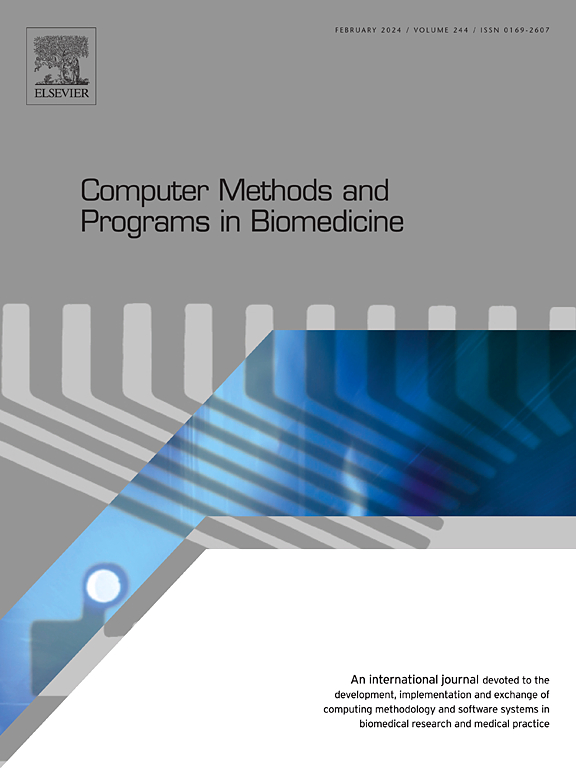Adaptive multilevel thresholding for SVD-based clutter filtering in ultrafast transthoracic coronary flow imaging
IF 4.8
2区 医学
Q1 COMPUTER SCIENCE, INTERDISCIPLINARY APPLICATIONS
引用次数: 0
Abstract
Background and Objective:
The integration of ultrafast Doppler imaging with singular value decomposition clutter filtering has demonstrated notable enhancements in flow measurement and Doppler sensitivity, surpassing conventional Doppler techniques. However, in the context of transthoracic coronary flow imaging, additional challenges arise due to factors such as the utilization of unfocused diverging waves, constraints in spatial and temporal resolution for achieving deep penetration, and rapid tissue motion. These challenges pose difficulties for ultrafast Doppler imaging and singular value decomposition in determining optimal tissue-blood (TB) and blood-noise (BN) thresholds, thereby limiting their ability to deliver high-contrast Doppler images.
Methods:
This study introduces a novel local blood subspace detection method that utilizes multilevel thresholding by the valley-emphasized Otsu’s method to estimate the TB and BN thresholds on a pixel-based level, operating under the assumption that the magnitude of the spatial singular vector curve of each pixel resembles the shape of a trimodal Gaussian. Upon obtaining the local TB and BN thresholds, a weighted mask (WM) is generated to assess the blood content in each pixel. To enhance the computational efficiency of this pixel-based algorithm, a dedicated tree-structure -means clustering approach, further enhanced by noise rejection (NR) at each singular vector order, is proposed to group pixels with similar spatial singular vector curves, subsequently applying local thresholding (LT) on a cluster-based (CB) level.
Results:
The effectiveness of the proposed method was evaluated using an ex-vivo setup featuring a Langendorff swine heart. Comparative analysis with power Doppler images filtered using the conventional global thresholding method, which uniformly applies TB and BN thresholds to all pixels, revealed noteworthy enhancements. Specifically, our proposed CBLT+NR+WM approach demonstrated an average 10.8-dB and 11.2-dB increase in Contrast-to-Noise ratio and Contrast in suppressing the tissue signal, paralleled by an average 5-dB (Contrast-to-Noise ratio) and 9-dB (Contrast) increase in suppressing the noise signal.
Conclusions:
These results clearly indicate the capability of our method to attenuate residual tissue and noise signals compared to the global thresholding method, suggesting its promising utility in challenging transthoracic settings for coronary flow measurement.
超快冠状动脉血流成像中基于svd的杂波滤波自适应多阈值化。
背景与目的:超快多普勒成像与奇异值分解杂波滤波相结合,在流量测量和多普勒灵敏度方面有了显著的提高,超过了传统的多普勒技术。然而,在经胸冠状动脉血流成像的背景下,由于使用未聚焦的发散波,实现深度穿透的空间和时间分辨率的限制以及快速的组织运动等因素,会出现额外的挑战。这些挑战给超快多普勒成像和奇异值分解在确定最佳组织血(TB)和血噪声(BN)阈值方面带来了困难,从而限制了它们提供高对比度多普勒图像的能力。方法:本研究引入了一种新的局部血液子空间检测方法,该方法利用谷强调Otsu方法的多级阈值在基于像素的水平上估计TB和BN阈值,假设每个像素的空间奇异向量曲线的大小类似于三模态高斯曲线的形状。在获得局部TB和BN阈值后,生成加权掩码(WM)来评估每个像素中的血液含量。为了提高这种基于像素的算法的计算效率,提出了一种专用的树结构k-means聚类方法,并在每个奇异向量阶上进一步增强噪声抑制(NR),将具有相似空间奇异向量曲线的像素分组,然后在基于聚类(CB)的水平上应用局部阈值(LT)。结果:采用Langendorff猪心脏离体装置评估了所提出方法的有效性。与使用常规全局阈值法滤波的功率多普勒图像进行比较分析,该方法对所有像素统一应用TB和BN阈值,显示出显著的增强。具体来说,我们提出的CBLT+NR+WM方法在抑制组织信号方面显示出比噪比和对比度平均提高10.8 db和11.2 db,同时在抑制噪声信号方面平均提高5 db(比噪比)和9 db(对比度)。结论:这些结果清楚地表明,与全局阈值法相比,我们的方法能够减弱残余组织和噪声信号,这表明它在具有挑战性的经胸冠状动脉血流测量中具有很好的应用前景。
本文章由计算机程序翻译,如有差异,请以英文原文为准。
求助全文
约1分钟内获得全文
求助全文
来源期刊

Computer methods and programs in biomedicine
工程技术-工程:生物医学
CiteScore
12.30
自引率
6.60%
发文量
601
审稿时长
135 days
期刊介绍:
To encourage the development of formal computing methods, and their application in biomedical research and medical practice, by illustration of fundamental principles in biomedical informatics research; to stimulate basic research into application software design; to report the state of research of biomedical information processing projects; to report new computer methodologies applied in biomedical areas; the eventual distribution of demonstrable software to avoid duplication of effort; to provide a forum for discussion and improvement of existing software; to optimize contact between national organizations and regional user groups by promoting an international exchange of information on formal methods, standards and software in biomedicine.
Computer Methods and Programs in Biomedicine covers computing methodology and software systems derived from computing science for implementation in all aspects of biomedical research and medical practice. It is designed to serve: biochemists; biologists; geneticists; immunologists; neuroscientists; pharmacologists; toxicologists; clinicians; epidemiologists; psychiatrists; psychologists; cardiologists; chemists; (radio)physicists; computer scientists; programmers and systems analysts; biomedical, clinical, electrical and other engineers; teachers of medical informatics and users of educational software.
 求助内容:
求助内容: 应助结果提醒方式:
应助结果提醒方式:


